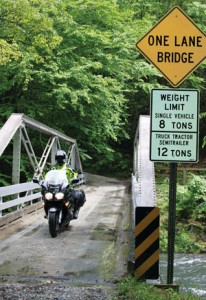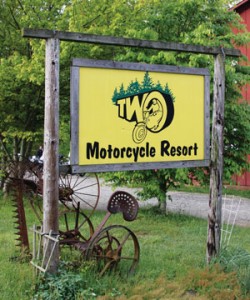photography by the author, Rick Oxton and Paul Drevenstedt
[This 2009 Yamaha FJR1300A/AE Tour Road Test was originally published in the September 2009 issue of Rider]
FJR Tour, 4:40 a.m.—Blink, blink…up early, picking up Paul, coffee & doughnuts from Russell’s, driving to LAX. (Posted on Twitter)
Planets aligned such that my brother Paul’s vacation coincided with an opportunity to test two 2009 Yamaha FJR1300 motorcycles on southeastern back roads. Arriving in our hometown of Nashville, we met Kevin Foley, Yamaha’s PR guy, and photographer Rick Oxton. We loaded our gear and hit the road.
Rider has tested the FJR1300 extensively and we give the bike two thumbs up. Our goal over the next six days and 1,400 miles was to answer a single question: operate the clutch manually, or let the bike do it for you? This is not a trivial question because the auto-clutch AE model’s MSRP ($16,290) is 1,800 bucks over that of the standard A model ($14,490).
The last time I rode the FJR1300A was a freeway blast down to San Diego for the Vmax intro, and I got a speeding ticket. Yamaha’s 1,298cc, in-line-four-powered sport tourer is very fast, and deceptively so. At 60 mph in top gear the engine churns smoothly and quietly at just over 3,000 rpm, only one-third of the way to redline. When we spun a 2006 FJR1300 on the dyno (Rider, August 2006), it chugged out 126 horsepower and 90 lb-ft of torque.

As we headed south and the city disappeared in our mirrors, we passed familiar signs: old red-and-black barns with “See Rock City” painted on them and billboards encouraging us to “See Ruby Falls.” Heavy, drought-ending rains had turned everything green, and we breathed in thick, earthy air punctuated by sweet notes of honeysuckle. Curving up the side of Monteagle Mountain the speed limit dropped. Mom used to dread driving over Monteagle with Paul and me in her yellow Volkswagen Kharman Ghia. The road was steeper and narrower back then, and the small, air-cooled car was dwarfed by semis as it struggled up the incline. We crested the peak and enjoyed the long sweepers down the other side, throttling toward a hot shower and a meat-heavy meal in Chattanooga.
FJR Tour, 7:05 a.m.—Day 2: Waffle House, then heading to Cherohala Skyway. Stoked!
After paying our respects at the Southern Temple of Road Food (pecan waffle extra-crispy and hash browns scattered, smothered and covered), we took U.S. 64 into Cherokee National Forest. What we thought would be a short cut turned out to be a wrong turn. After the winding two-lane road passed through the sleepy hollows of Greasy Creek and Reliance and along the Hiwassee River, we stopped for a map check (motorcyclists are rare men who don’t mind using maps).
 Swapping the A-model for the AE required some coaching from Kevin. First of all, the AE has no clutch lever. Second, the shift pattern is five up, with neutral at the bottom. Third, you can shift with your foot or use the left-handed trigger shifter. And last but not least, it takes trial and error to learn when the system engages and disengages the clutch. Dragging the rear brake police-bike-style during low-speed maneuvers helps.
Swapping the A-model for the AE required some coaching from Kevin. First of all, the AE has no clutch lever. Second, the shift pattern is five up, with neutral at the bottom. Third, you can shift with your foot or use the left-handed trigger shifter. And last but not least, it takes trial and error to learn when the system engages and disengages the clutch. Dragging the rear brake police-bike-style during low-speed maneuvers helps.
Yamaha Chip Control Shifting (Y-CCS), as it’s officially known, is a five-speed manual transmission mated to a computer-controlled clutch with electronic shift actuators. Y-CCS is said to “eliminate the fatigue of operating the clutch” and “put more emphasis on the enjoyment of the ride.” Of course, such benefits rest on the assumption that operating the clutch is tiresome and not enjoyable. Synchronized movement of the throttle, clutch and shifter contributes to the dynamic experience of riding. I enjoy the finesse required to shift smoothly. That being said, what is Y-CCS like, on its own terms? Spending several days with it on the road is the best way to find out.
We headed for the Cherohala Skyway, a mash-up of two national forests the road passes through: Cherokee in Tennessee and Nantahala in North Carolina. Winding up and over 5,000-foot mountains, the Skyway offers ridgeline vistas and fast-paced sweepers. As we clicked off miles, I had difficulty executing smooth shifts on the AE. With no clutch to pull in, blipping the throttle isn’t easy. Momentarily rolling off the throttle helps, but I really missed the ability to modulate clutch engagement. Old habits die hard. On the other hand, the AE model excels at shifting during acceleration, similar to the new quick-shifter equipped BMW K1300S.
After kicking tires at the Deal’s Gap Motorcycle Resort, we completed our obligatory up-and-back run of those infamous “318 curves in 11 miles.” Gassed up on Dragon Unleaded, we took NC 28 along the Little Tennessee River toward Fontana Dam. This is the best road in the area, with excellent tarmac, a good mix of tight curves and fast sweepers and great scenery. We made our way to the Blue Ridge Parkway, where darkness and misting rain fell as we arrived at Mt. Pisgah Inn.
 Although my mental jury was still out on the AE’s automatic clutch, I had grown fond of the FJR1300 after riding it all day on blue highways. Powerful and nimble, with plenty of comfort and amenities for the long haul—exactly what a sport tourer should be. Stand-out features include a rigid aluminum frame, a low-maintenance shaft drive, a push-button adjustable windscreen and standard hard saddlebags ($99.95 optional liner bags are a must). The touring trunk ($439.95, plus $115.95 for mounting kit) offers 1.83 cubic feet of extra storage space. The wide, flat seat is comfortable and offers an inch of height adjustability for the rider. And with a 6.6-gallon fuel tank and 40 mpg, you can easily cover 250 miles between fill-ups.
Although my mental jury was still out on the AE’s automatic clutch, I had grown fond of the FJR1300 after riding it all day on blue highways. Powerful and nimble, with plenty of comfort and amenities for the long haul—exactly what a sport tourer should be. Stand-out features include a rigid aluminum frame, a low-maintenance shaft drive, a push-button adjustable windscreen and standard hard saddlebags ($99.95 optional liner bags are a must). The touring trunk ($439.95, plus $115.95 for mounting kit) offers 1.83 cubic feet of extra storage space. The wide, flat seat is comfortable and offers an inch of height adjustability for the rider. And with a 6.6-gallon fuel tank and 40 mpg, you can easily cover 250 miles between fill-ups.
FJR Tour, 1:37 p.m.—Day 3, Blue Ridge Pkwy socked in with fog this a.m. In Highland, NC, headed to Suches & Two Wheels Only.
Heavy fog denied us views, speed and photo ops on the Blue Ridge Parkway. Riding to lower elevations we caught glimpses of valleys full of blooming pink and white rhododendrons. We exited the Parkway near Balsam and navigated winding roads into north Georgia. After riding GA 180 along the northern border of the Chattahoochee National Forest, we turned onto Wolf Pen Gap Road for 12 challenging miles of tight switchbacks under dense tree cover. In Suches we checked into TWO (Two Wheels Only), a rustic motorcycle campground and lodge, and then joined local riders Jim Chappell and Jon Davisson for dinner
at the Smith House in Dahlonega. We swapped riding stories and passed around platters of fried chicken, ham, mashed potatoes, gravy, fried okra, collard greens and cole slaw, washed down with sweet tea.
FJR Tour, 12:52 p.m.—Day 4, now just Greg & Paul. Back in NC, headed for cool, scenic waters on Nantahala R.
Kevin and Rick had planes to catch, so we parted ways. Paul and I continued on, returning to North Carolina to revisit Nantahala River Gorge and fond childhood memories of whitewater rafting. Rain motivated us to stop for lunch, and our patio table overlooked a bridge where the Appalachian Trail crosses the Nantahala River. Wet, determined through-hikers walked across the bridge as kayakers played in the rapids below. The rain continued after lunch, so we were easy on the throttle as we rode alongside the river and over Wayah Bald, negotiating tight hairpins full of wet leaves. As we were heading toward Atlanta on a Friday afternoon, the skies cleared, temperatures rose and traffic grew heavy. Our good friend Stefan Kallweit was waiting for us in his driveway with cold beers and ribs smoking on the grill.
FJR Tour, 2:24 p.m.—Day 5. Had lunch with family, stopped at Stone Mtn Park, headed north to Nashville soon. Rain, rain, go away….
FJR Tour, 5:32 p.m.—About to go over Monteagle Mtn. Started pouring rain at Nickajack Lake. Biblical rain.
 Over two days, Paul and I flogged the FJRs in the mountains and the city, on back roads and the superslab. Steady rain tested the water resistance of our attire, but locking hard luggage kept our gear dry, heated grips ($387.49 option on the A-model, standard on the AE) kept our hands warm and linked ABS brakes provided reassurance. At speed, the bikes were stable and plowed through wet roads without the slightest hint of squirminess. We returned to Nashville to visit more family and to stay with Aubrey Parker, an elementary school pal and fellow rider.
Over two days, Paul and I flogged the FJRs in the mountains and the city, on back roads and the superslab. Steady rain tested the water resistance of our attire, but locking hard luggage kept our gear dry, heated grips ($387.49 option on the A-model, standard on the AE) kept our hands warm and linked ABS brakes provided reassurance. At speed, the bikes were stable and plowed through wet roads without the slightest hint of squirminess. We returned to Nashville to visit more family and to stay with Aubrey Parker, an elementary school pal and fellow rider.
FJR Tour, 9:13 a.m.—Day 6. Rode last 5 miles of Natchez Trace Pkwy to Loveless Café. Tucking into biscuits and sorghum…yum!
We awoke Sunday to find the skies overcast but mercifully free of rain. After a country breakfast at world-famous Loveless Café, we rode a few hundred yards to the northern terminus of the Natchez Trace Parkway. I rode all 444 miles of the Trace in 2005, and the last few miles have the best curves. We spent our last few hours in Nashville visiting landmarks and our childhood home before heading back to the airport.
Just as siblings hate it when parents play favorites, I’m loath to do the same when it comes to the A and AE models in the FJR1300 family. This is an excellent sport-touring platform with a strong following. Motorcycle Industry Council sales numbers for 2008 rank Yamaha #2 after BMW in the Sport Touring category. And Yamaha claims that about 25 percent of FJR sales are for the more expensive AE model. That last bit is a real head-scratcher because I find the automatic clutch to be finicky, which detracts from my control and enjoyment of the ride. For my $1,800, give me the touring trunk and mounting kit, saddlebag liners and heated grips, and I’ll use the remaining $750 on gas. At $3 per gallon, that’ll get me 10,000 miles of sport-touring fun.
Watch video from this tour test:
Click here to view 2009 Yamaha FJR1300A/AE Tour Road Test Video Part 1
Click here to view 2009 Yamaha FJR1300A/AE Tour Road Test Video Part 2







